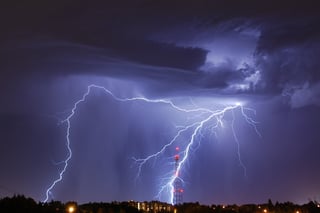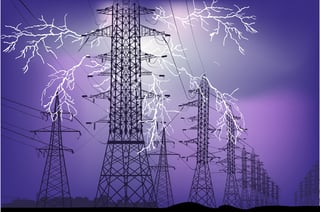Thunderstorm Season (Yes, That's a Thing!) | Telos Alliance
By The Telos Alliance Team on Jun 7, 2017 1:00:00 PM
 Thunderstorm Season (Yes, That's a Thing!)
Thunderstorm Season (Yes, That's a Thing!)
In the wintertime, humidity levels plummet as temperatures drop and forced air heating systems dry the air out even more. During these months we are extra conscious of electrostatic discharge. Many will make a habit of grounding themselves to a doorknob or rack case before touching any controls in the studio, so as to avoid zapping the electronics with static electricity.
When winter gives way to warmer weather, thunderstorms and line surges present a new threat to our precious technology. Broadcast engineers take steps to protect their mains power inputs with spike suppressors and surge protectors. These devices can help, but can only do so much with the extremely fast transient swings in voltage that are observed during these events. There are also threats that are not so obvious.
At the Telos Alliance, we work very closely with radio stations throughout the world and there are two places besides mains power where we see the effects of thunderstorms the most: the tower and transmitter site (the most obvious), and the other (which is not so obvious), the phone system.
Antenna Tower
Since the days of Benjamin Franklin, we have been aware that the tallest thing in the area attached to ground will be hit by lightning during a storm. So naturally, an antenna tower is a perfect target. When lightning strikes the tower, the surge will travel to the transmitter. The transmitter, which is built to manage high voltages, will pass the surge on to the final stage processor. Since transmission processors like the Omnia ONE handle line level signals, they may respond to a lightning strike by emitting maximum smoke. The way some get around this is to use a fiber or radio-based Studio to Transmitter Link (STL) like Kirk Harnack described for us in an in-depth blog post last year.
Phone Lines
When a thunderstorm rolls through a nearby town, a surge from a lightning strike can travel for many, many miles. In full copper legacy telephone systems, surges can impact many states at a time, several times per day. In fact, there may be no sign of a thunderstorm, but a surge from a thunderstorm across the state or even the country can travel to your equipment through the telephone network. Most telephone equipment is designed to handle this–to an extent. In older days, large carbon resistors were added to home telephone systems to suppress these events. In addition, legacy POTS telephones have no silicon chipsets to burn up, so they could handle these spikes gracefully. Historically, the devices that need to be protected are those with logic and digital circuits inside like fax machines, cordless telephones, computer modems, answering machines, etc. Since radio equipment doesn't really fit into the normal realm of consumer electronics, telephone hybrids are often left off of this list but should not be forgotten!

In the case of ISDN and our legacy series 2101 system, the system hub was protected by the required external CSU/DSU device, which is placed between the phone company and the 2101 system. This way the CSU/DSU would get damaged during an event but not the $8,000 PRI card in the 2101 hub.
Since no in-line interface is needed for a POTS line or a BRI using ISDN-U, protection is usually foregone and the equipment is plugged directly into the line. There is nothing wrong with this, but it means that the telecom interface inside the equipment is the first line of defense against surges. This will result in one of many support calls we take every year that are resolved by a trip to our repair department. The repairs range from a simple component replacement to an entire mainboard needing changed.
When it comes to protecting phone lines, there are some in-line solutions that can be used that are similar to mains power line surge protectors. Check out your nearest electronics store, or you can go to sandman.com for some options. Keep in mind that surge transients can still sometimes sneak by even the best protection money can buy. The safest solution to preventing thunderstorm damage has been the same since the beginning: Just unplug it!
Telos Alliance has led the audio industry’s innovation in Broadcast Audio, Digital Mixing & Mastering, Audio Processors & Compression, Broadcast Mixing Consoles, Audio Interfaces, AoIP & VoIP for over three decades. The Telos Alliance family of products include Telos® Systems, Omnia® Audio, Axia® Audio, Linear Acoustic®, 25-Seven® Systems, Minnetonka™ Audio and Jünger Audio. Covering all ranges of Audio Applications for Radio & Television from Telos Infinity IP Intercom Systems, Jünger Audio AIXpressor Audio Processor, Omnia 11 Radio Processors, Axia Networked Quasar Broadcast Mixing Consoles and Linear Acoustic AMS Audio Quality Loudness Monitoring and 25-Seven TVC-15 Watermark Analyzer & Monitor. Telos Alliance offers audio solutions for any and every Radio, Television, Live Events, Podcast & Live Streaming Studio With Telos Alliance “Broadcast Without Limits.”
More Topics: Broadcast Technology, Broadcast Engineering, Telephone Systems
Recent Posts
Subscribe
If you love broadcast audio, you'll love Telos Alliance's newsletter. Get it delivered to your inbox by subscribing below!